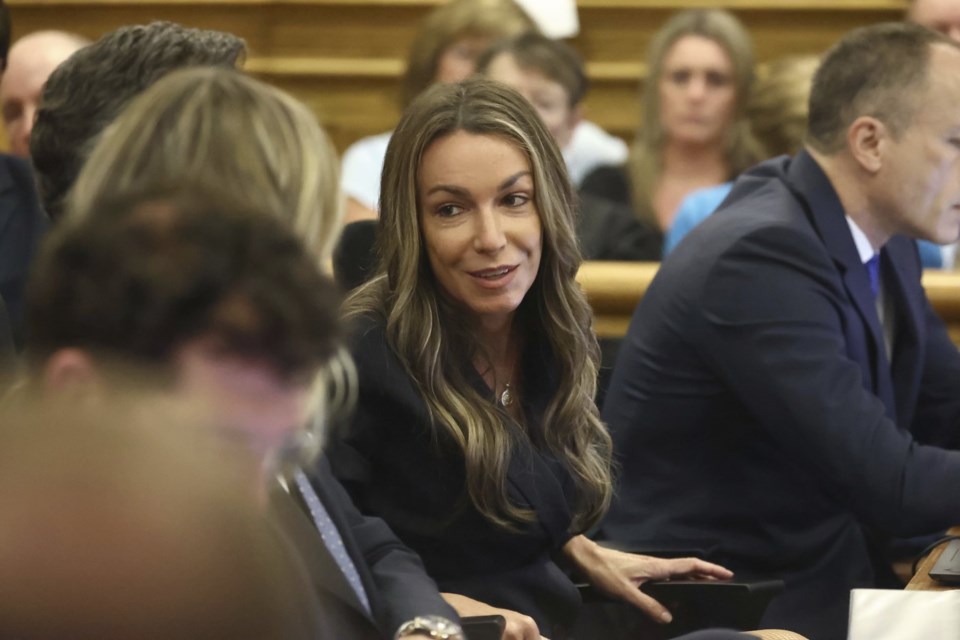DEDHAM, Mass. (AP) — Karen Read’s second murder trial began Tuesday with a prosecutor saying the defendant’s own words will bolster evidence that she killed her police officer boyfriend three years ago and a defense attorney calling the case “the definition of reasonable doubt.”
Read is accused of striking her boyfriend, John O’Keefe, with her SUV in 2022 and leaving him to die alone in the snow outside of a house party in Canton, a suburb about 20 miles (32 kilometers) south of Boston. She has been charged with second-degree murder, manslaughter while operating a vehicle under the influence and leaving the scene.
Prosecutors say Read intentionally backed into O’Keefe after she dropped him off at a house party and returned hours later to find him dead. The defense says that she was a victim of a vast police conspiracy and that O’Keefe was fatally beaten by another law enforcement officer at the party.
A mistrial was declared last year after jurors said they were at an impasse and deliberating further would be futile.
The biggest difference in the current trial is the lead prosecutor, Hank Brennan. Brought in as a special prosecutor after the mistrial, the former defense attorney has represented a number of prominent clients, including notorious Boston gangster James “Whitey” Bulger.
Brennan began his opening statement Tuesday by describing the firefighter who raced to the scene in near-blizzard conditions and found Read and two other women surrounding O’Keefe’s body on the ground.
“He stepped out into bedlam,” he said.
The firefighter then asked Read what had happened, he said.
“You’ll hear her words, ’I hit him. I hit him. I hit him,” Brennan said. “She admitted what she had done that night.”
Brennan told jurors that “facts and data” will lead them to the truth, and that Read’s own statements will confirm it. He played a clip from a television interview in which Read said, “I mean, I didn’t think I ‘hit him’ hit him, but could I have clipped him? Could I have tagged him in the knee and incapacitated him? He didn’t look mortally wounded, as far as I could see. Could I have done something that knocked him out, and in his drunkenness and in the cold, he didn’t come to again?”
But Defense Attorney Alan Jackson began his opening statement by saying the prosecution’s case was based on a “brazen and flawed assertion that is untethered to the facts and the evidence.”
“John O'Keefe did not die from being hit by a vehicle,” he said. "The facts will show that. The evidence will show that. The data will show that. The science will show that and the experts will tell you that.”
Many of the factors that made the first trial must-see television will feature in the second. Most of the same witnesses are back as are Read’s aggressive defense team and dozens of her supporters camped out near the courthouse — many carrying “Free Karen Read” signs and wearing pink. Read, who has been featured in several documentaries about her case, has become a minor celebrity.
On Tuesday, a few dozen of Read's supporters, many holding American flags, stood in front of the courthouse before moving a block away to comply with a court-ordered buffer zone. Those who were reuniting hugged each other, while others took time to bring newcomers up to speed on the case.
“I'm here for justice,” said Ashlyn Wade, a Read supporter from Canton. “The murderer going to jail and Karen being exonerated, that would be justice.”
The prosecution, however, stands to benefit from a pretrial ruling from Judge Beverly Cannone barring defense attorneys from mentioning potential third-party culprits in their opening statements. They can develop a case against two law enforcement officers but cannot implicate Albert’s nephew, Colin Albert, as they did in the first trial.
“I view it as a blow to the defense strategy but not a knockout punch,” Daniel Medwed, a law professor at Northeastern University, said of the ruling. “All the defense needs to do is create reasonable doubt about Karen (Read's) guilt, and that doesn’t require pointing to an alternative perpetrator as a matter of law.”
Jackson called the prosecution's case “the literal definition of reasonable doubt" in his opening statement and said the heavy burden of proof will not be met given that "every piece of this case was handled by a disgraced investigator with a motive to protect his friends”
“By the end of this trial, you’ll conclude that Karen Read is not guilty," he said. “She’s the victim of a botched and biased and corrupted investigation that was never about the truth, folks. It was about preserving loyalty.”
One of the key witnesses will be former State Trooper Michael Proctor. He led the investigation but has since been fired after a disciplinary board found that he sent sexist and crude texts about Read to his family and colleagues. Jackson called him a “cancer” that infected every step of the investigation and characterized him as both the key to the state's case and its Achilles' heel.
Legal experts expect prosecutors to focus on Read's behavior as they did during the first trial — her volatile relationship with O'Keefe and their night of heavy drinking. They also predict the prosecution will lay out a stronger and more coherent case that Read clipped O'Keefe with the back of her SUV and sent him tumbling to the ground — using data from her car, video and stronger expert testimony.
“The Commonwealth will focus on the theme drilled into us since middle school — Drinking, Driving, Deadly Consequences,” Michael Coyne, the dean of Massachusetts School of Law at Andover, said in an email.
Michael Casey, The Associated Press



